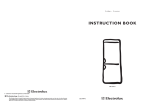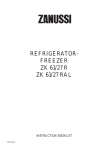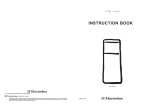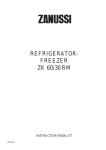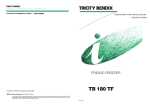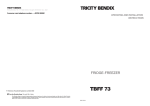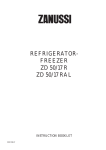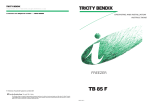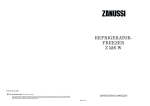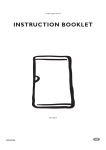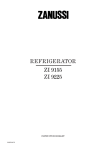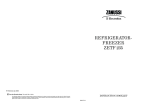Download Electrolux ER 1825 D User's Manual
Transcript
fridge - freezer INSTRUCTION BOOK ER 1825 D © Electrolux Household Appliances Limited 2001 2222 233-92 IMPORTANT SAFETY INFORMATION It is most important that this instruction book should be retained with the appliance for future reference. Should the appliance be sold or transferred to another owner, or should you move house and leave the appliance, always ensure that the book is left with the appliance in order that the new owner can get to know the functioning of the appliance and the relevant safety information. This information has been provided in the interest of safety. You MUST read it carefully before installing or using the appliance. Installation ¥ This appliance is heavy. Care should be taken when moving it. It is dangerous to alter the specifications or attempt to modify this product in any way. Care must be taken to ensure that the appliance does not stand on the electrical supply cable. Important: if the supply cable is damaged, it must be replaced by a special cable available from Expert Appliance Care. Any electrical work required to install this appliance should be carried out by a qualified electrician or competent person. Parts which heat up should not be exposed. Whenever possible, the back of the appliance should be close to a wall but leaving the required distance for ventilation as stated in the installation instructions. The appliance should be left for 2 hours after installation before it is turned on, in order to allow the refrigerant to settle. ¥ ¥ ¥ ¥ ¥ ¥ Do not remove items from the freezer if your hands are damp/wet, as this could cause skin abrasions or frost/freezer burns. ¥ Ice lollies can cause Ôfrost/freezer burnsÕ if consumed straight from the freezer. ¥ ManufacturersÕ storage recommendations should be strictly adhered to. Refer to relevant instructions. ¥ The cooling plate or refrigerated freezer shelves in this appliance contain channels through which the refrigerant passes. If these are punctured this will cause substantial damage to the appliance and result in food loss. DO NOT USE SHARP INSTRUMENTS to scrape off frost or ice. Under NO circumstances should solid ice be forced off the lining or shelves. Solid ice should be allowed to thaw, when defrosting the appliance. See Defrost Instructions. Maintenance and Cleaning Child Safety ¥ ¥ Do not allow children to tamper with the controls or play with the product. Servicing ¥ Keep all packaging well away from children. ¥ This product should be serviced by an authorised engineer and only genuine spare parts should be used. ¥ Under no circumstances should you attempt to repair the machine yourself. Repairs carried out by inexperienced persons may cause injury or serious malfunctioning. Contact Expert appliance Care. General Safety ¥ Take utmost care when handling your appliance so as not to cause any damages to the cooling unit with consequent possible fluid leakages. The appliance must not be located close to radiators or boilers. Avoid prolonged exposure of the appliance to direct sunlight. Do not use other electrical appliances (such as ice cream makers) inside of refrigerating appliances. ¥ ¥ ¥ During Use ¥ This appliance is designed for domestic use only, specifically for the storage of edible foodstuffs. ¥ Frozen food must NOT be re-frozen once it has thawed out. ¥ Do not place carbonated or fizzy drinks in the freezer. 2 Switch off and unplug the appliance before carrying out any cleaning or maintenance work. At the end of the Appliance Life ¥ When disposing of your appliance, use an authorised disposal site. ¥ Remove the plug and ensure that any locks or catches are removed, to prevent young children being trapped inside. CONTENTS Instructions for the User Important Safety Information 2 Instructions for the Installer Description of the Appliance 4 Technical Specification 13 Operation 5 Installation 14 Before use 5 Positioning 14 Setting the temperature 5 Rear spacers 14 The freezer compartment 5 Electrical Connection 15 Freezing fresh food 5 Storage of frozen food 5 Door Reversal 16 Thawing 6 Making ice cubes 6 Fresh food refrigeration 6 Movable shelves 7 Freezing Calendar 7 Hints and Tips 8 Maintenance and Cleaning 9 Internal cleaning 9 External cleaning 9 When the appliance is not in use 9 Changing the light bulb 9 Defrosting 9 Something Not Working 11 Service and Spare Parts 12 2222 233-92 3 DESCRIPTION OF THE APPLIANCE A B C J D I E H G A- Ice tray B- Shelf for freezing fresh foods C- Frozen food storage D- Storage shelf E- Storage shelf F- Bottle storage shelf G- Salad crisper (to keep fruit and vegetables fresh) H- Glass shelf (for storing fresh meat) I- Cooked foods storage shelves J- Thermostat control knob for both compartments 4 F OPERATION Door reversal Before using 1. Disconnect from the electricity supply; 2. Remove all loose item, including food, store food in a cool place; G 3. Gently lay the fridge/freezer on its back with the top held away from the floor by 5-8 cm (2-3 inches) of packing; Do not use soap or detergent as the smell may linger. Dry thoroughly. 4. Remove the feet (2-3). Setting the temperature 5. Unscrew the bottom hinge (1). 6. Slide out the lower door from middle hinge (H) and remove the latter. The temperature inside the refrigerator is regulated by a thermostat with 6 temperature positions and one ÇOFFÈ (O) position. H 7. Slide out the upper door from pin (G), unscrew the latter and then screw it down into the hinge provided on the opposite side, after having removed the small plugs which should then be fitted on the opposite side. Position 1 = minimum coldness Position 6 = maximum coldness Turn the thermostat dial to the required position. The intermediate position is usually the most suitable (3-4). 8. Refit the upper door and the middle hinge on the opposite side. The thermostat setting can vary as the temperature inside the refrigeration compartment depends on the following factors: 9. Screw down the bottom hinge (1) on the opposite side by using the screws previously removed. 10.Refit the feet (2-3) on the opposite side. Ð how often the door is opened Ð how much food is stored Ð position of the appliance 12.The doors can be aligned by adjusting the middle hinge. Attention After completion of the door reversing operation, check that the door gasket adheres to the cabinet. If the ambient temperature is cold (i.e. in Winter), the gasket may not fit perfectly to the cabinet. In that case, wait for the natural fitting of the gasket or accelerate this process by heating up the part involved with a normal hairdryer on a low setting. Important In the event of a power cut do not open the door. The food in the freezer will not be affected if the power cut is short and if the freezer is full. Should the food begin to thaw, it must be consumed quickly and must not be re-frozen. Storage of frozen food When first starting-up or after a period of use, before putting the products in the compartment let the appliance run for at least two hours on the coldest setting, then turn the thermostat knob to the normal opertion position. Do not exceed the storage period indicated by the manufacturer. Finally, do not open the door frequently or leave it open longer than is absolutely necessary. Ð room temperature 11. Unscrew the handle. Refit it on the opposite side after having pierced the plugs with a punch. Cover the holes left open with the plugs contained in the documentation pack. 13.The middle hinge can be adjusted horizontally, with the help of a tool, after having slackened the two screws. Remove all securing tapes. Wash inside the appliance with lukewarm water and bicarbonate of soda (5 ml to 0.5 litre of water). Place the food to be frozen on the shelf of the freezer as this is the coldest part. Important During prolonged periods of abnormally hot weather, if the thermostat is set on too high a number, the cooling system may operate continuously and the fridge cooling plate may not defrost. Turning the knob to a lower number will cause the automatic defrosting to resume. PR228 3 Do not put carbonated liquids, (fizzy drinks etc.), in the freezer compartment. Ice Iollies, if consumed immediately after removal from the freezer, can cause low temperature skin burns. Do not remove items from the freezer if your hands are damp/wet, as this could cause skin abrasions or Òfrost/freezer burnsÓ. The freezer compartment 1 2 D715 PIED/M Warning The four-star freezer compartment is suitable for storage of commercially frozen food and for freezing fresh foods. Freezing fresh food To freeze fresh foods it is not necessary to change the setting of the thermostat knob. However, for a quicker freezing operation, turn the thermostat knob to the coldest setting; but remember that, in this condition the refrigerator compartment temperature might drop below 0¡ C. If this occurs reset thermostat knob to a warmer setting. In any 24 hours you can freeze up to 3 kg. of fresh food. 16 5 Thawing Fresh food refrigeration Frozen food, prior to being used, can be thawed in the fridge or at room temperature depending on the time available. Small food items may even be cooked from frozen; in this case cooking will take longer. To obtain the best performance, do not store warm food or evaporating liquids in the refrigerator; do cover or wrap the food, particularly if it has a strong flavour. Any frozen food which is allowed to thaw accidentally should either be eaten as soon as possible or thrown away. Alternatively, if the food is uncooked and has not been completely defrosted it can be cooked and then refrozen. Meat, fish and fruit should be thawed in the refrigerator compartment and small pieces of meat can even be cooked while still frozen, but you must ensure that it is thoroughly cooked through. Vegetables should be directly immersed in boiling water; ready-cooked dishes can be placed directly in the oven in their aluminium wrapping. A microwave oven is particularly suitable for thawing any type of frozen food: follow the oven instructions, particularly regarding the placement of aluminium wrapping or containers in the oven. Defrosted cooked food must never be refrozen. Making ice cubes The appliance is provided with one or more trays for ice-cubes trays. Fill the tray(s) 3/4 full to give the ice space to expand and place them in the freezer compartment. To release the ice cubes simply give the tray a slight twist. Do not cover the shelves with any protective material, such as paper, cardboard or plastic, which may obstruct the air circulation through them. To help you use your refrigerator correctly, here are some more useful hints: Raw meat (beef, pork, lamb & poultry): wrap in polythene bags and place on top of the salad crisper. Meat can only be stored safely in this way for one or two days at the most. Fruit & vegetables: these should be thoroughly cleaned and placed in the bottom salad crisper. Butter & cheese: these should be placed in special airtight containers or wrapped in aluminium foil or polythene bags to exclude as much air as possible. Milk bottles: these should have a cap and should be stored in the bottle rack on the door. Electrical connections Any electrical work required to install this appliance should be carried out by a qualified electrician or competent person. The plug moulded onto the lead incorporates a fuse. For replacement, use a 13amp BSI362 fuse. Only ASTA or BSI approved fuses should be used. The plug must not be used if the fuse cover/carrier is lost. The cover/carrier is indicated by the coloured insert at the base of the plug. WARNING: THIS APPLIANCE MUST BE EARTHED. A replacement cover/carrier must be obtained from Expert Appliance Care. The manufacturer declines any liability should this safety measure not be observed. This appliance complies with the E.E.C. Directive No. 87/308 of 2.6.87 relative to radio interference suppression. If the plug that is fitted to your appliance is not suitable for your socket outlet, it must be cut off and the appropriate plug fitted. This appliance complies with the following E.E.C. Directives: Remove the fuse from the cut off plug. - The cut off plug should then be disposed of to prevent the hazard of shocks in case it should be plugged into a 13amp socket in another part of your home. 73/23 EEC of 19.2.73 (Low Voltage Directive) and subsequent modifications; - 89/336 EEC of 3.5.89 (Electromagnetic Compatibility Directive) and subsequent modifications. Important The wires in the mains lead are coloured in accordance with the following code: Green and Yellow - Earth Blue - Neutral Brown - Live Please ensure that when the appliance is installed it is easily accessible for the engineer in the event of a breakdown. If you fit your own plug, the colours of the wires in the mains lead of your appliance may not correspond with the markings identifying the terminals in your plug, proceed as follows: GREEN & YELLOW 13 AMP Do not use sharp or metallic instruments to remove the trays from the freezer. 13 AMP. FUSE BROWN BLUE D207 CORD CLAMP Connect the Green and Yellow (earth) wire to the terminal in the plug which is marked with the letter ÇEÈ or the earth symbol yellow. or coloured green and Connect the blue (neutral) wire to the terminal in the plug which is marked with the letter ÇNÈ or coloured black. Connect the brown (live) wire to the terminal in the plug which is marked with the letter ÇLÈ or coloured red. 6 15 INSTALLATION Warning IF YOU ARE DISCARDING AN OLD APPLIANCE THAT HAS A LOCK OR CATCH ON THE DOOR, YOU MUST ENSURE THAT IT IS MADE UNUSABLE TO PREVENT YOUNG CHILDREN BEING TRAPPED INSIDE. Movable shelves The walls of the refrigerator have runners so that shelves can be positioned as desired. Important It must be possible to disconnect the appliance from the mains power supply; the plug must therefore be easily accessible after installation. D040 Depending upon the position which you choose for your appliance, you may wish to reverse the way in which the door opens. To do this, refer to instructions under ÒDoor reversalÓ. The door shelves can be easily removed for cleaning. Gently ease the shelf in the directions shown. Adjustment of the door shelves can be made to accommodate varying heights of bottles and other containers. Store light items such as small cartons and jars on the door shelves. A B 10 mm You should also ensure that air can circulate freely around the back and the top of the cabinet. There must also be at least 100 mm (4Ó) distance between the top of the cabinet and any overhanging kitchen furniture (A). Ideally, the appliance should not be positioned beneath overhanging furniture (B). PR187 10 mm This appliance is designed to operate in ambient temperatures between 10¡C (50¡F) and 32¡C (90¡F). It should be located in a dry atmosphere, out of direct sunlight and away from extreme temperature e.g. not next to a boiler or radiator, or in a very cold room e.g. an outhouse, where the temperatures may fall below 10¡C (50¡F). If these temperatures are exceeded i.e. colder or warmer, then the appliance may not operate correctly. 100 mm Positioning The bottle shelf can be used for the storage of heavier bottles. NP005 There should also be a gap of 25 mm either side of the appliance. Do not obstruct the space underneath. The back of the cabinet may be placed close to the wall but must not touch it. DO NOT install in places with restricted ventilation. PR190 Adjust the level of the appliance by screwing out the adjustable foot, or feet, at the bottom of the cabinet using your fingers (see figure). Freezing Calendar D200 Rear spacers The plastic bag containing all relevant documentation also contains two spacers to be fitted into special holes in the back of the appliance. Fit the spacers into the holes, taking care to ensure that the arrow (A) is positioned as shown in the Figure. Then turn them through 45¡ (arrow (A) vertical) until they lock into place. 1-2 A 45° 3-4 3-6 3-6 3-6 3-6 10 -12 10 -12 10 -12 10 -12 The symbols show different types of frozen goods. The numbers indicate storage times in months for the appropriate types of frozen goods. Whether the upper or lower value of the indicated storage time is valid depends on the quality of the foods and treatment before freezing. PR60 14 7 HINTS AND TIPS TECHNICAL SPECIFICATIONS Energy Saving Advice Normal Operating Sounds ¥ ¥ ¥ You may hear faint gurgling or bubbling sounds when the refrigerant is pumped through the coils or tubing at the rear, to the cooling plate/evaporator. Do not install the appliance close to sources of heat, such as a boiler or radiator. ¥ Locate the appliance in a cool well ventilated room and make sure that the air openings of the appliance are not obstructed. When the compressor is on, the refrigerant is being pumped round, and you will hear a whirring sound or pulsating noise from the compressor. ¥ A thermostat controls the compressor, and you will hear a faint ÕclickÕ when the thermostat cuts in and out. Avoid unnecessary frosting in the cabinet by packing all foodstuffs into airtight packages before placing them in the freezer. ¥ Always leave warm food to cool down to room temperature before placing in the fridge. ¥ Food which is to be frozen (when cool) should be placed in the fridge before being transferred to the freezer. ¥ Thaw frozen food in the fridge. This will ensure safer defrosting of foods and reduce the work of the refrigeration unit. ¥ Try to avoid keeping the door open for long periods or opening the door too frequently as warm air will enter the cabinet and cause the compressor to switch on unnecessarily often. Food Storage To obtain the best performance from your fridgefreezer ¥ Do not store warm food or evaporating liquids. ¥ Avoid buying frozen food if you cannot store it straight away. The use of an insulated container is advisable. When you arrive home place the frozen food in the freezer immediately. ¥ Keep the time between buying chilled food and placing it in your refrigerator as short as possible. ¥ Do not push food together too much, try to allow air to circulate around each item. ¥ Do not store food uncovered. ¥ Ensure that food placed in the freezer is dated and labelled and used in date order to ensure that food is consumed at its best. ¥ Remove suspect food from your refrigerator and clean, refer to Maintenance and Cleaning. ¥ Lean food keeps better and longer than fatty food, salt reduces the storage time. ¥ Wrap the food in polythene or aluminium freezing bags or foil so that they adhere to the food and provide an airtight seal . ¥ Packaging which is swollen or has traces of refrozen water droplets on the pack could indicate that the product has not been kept at a suitable temperature and that it may have lost its original quality. Partially thawed food must not be refrozen, it must be consumed within 24 hours. Never exceed the storage times indicated by the manufacturer. 8 ¥ ¥ Ensure there are no obstructions preventing the door from closing properly. In the Event of a Power Failure DIMENSIONS Height 120 cm Width 49.5 cm Depth 60 cm POWER SUPPLY VOLTAGE AND FREQUENCY 220-240 V / 50 Hz TOTAL POWER ABSORBED 100 W AVERAGE DAILY UNITS ELECTRICITY * 0.84 kWh GROSS CAPACITY Fridge Freezer 138 l 42 l NET CAPACITY Fridge Freezer 136 l 42 l * This figure is based on standard test results in accordance with European Standard EN 153. Actual consumption will depend on how the appliance is used and where it is located. If there is a power failure during the storage of frozen foods, keep the door closed. If the temperature within your freezer should rise, do not refreeze the food without checking its condition. The following guidelines should assist you: Ice-cream: Once thawed should be discarded. Fruits & Vegetables: If soft should be cooked and used up. Breads & Cakes: Can be refrozen without danger. Shellfish: Should be refrigerated and used up quickly. Cooked Dishes: i. e. casseroles should be refrigerated and used up. Large Pieces of Meat: Can be refrozen providing there are still ice crystals remaining within them. Small Joints: Should be cooked and can then be refrozen as cooked dishes. Chicken: Should also be cooked and refrozen as a fresh dish. 13 SERVICE AND SPARE PARTS MAINTENANCE AND CLEANING If you require further information regarding the appliance, the terms and conditions of the guarantee, or wish to call out engineer, please contact Expert Appliance Care by telephoning:- Before any maintenance or cleaning work is carried out, DISCONNECT the appliance from the ELECTRICITY supply. 0870 9099100 Internal cleaning Changing the light bulb Should the interior light fail to work, first switch off the appliance and disconnect from the electricity supply, then replace the bulb as follows; Clean the inside and accessories with warm water and bicarbonate of soda (5ml to 0.5 litre of water). Rinse and dry thoroughly. NEVER USE DETERGENTS, ABRASIVE POWDERS, HIGHLY PERFUMED CLEANING PRODUCTS OR WAX POLISHES, TO CLEAN THE INTERIOR AS THESE WILL DAMAGE THE SURFACE AND LEAVE A STRONG SMELL. External cleaning Wash the outer cabinet with warm soapy water. Do NOT use abrasive products. An accumulation of dust will affect the performance of the appliance and cause excessive electricity consumption. Once or twice a year dust the condenser (black grill) and the compressor at the back of the appliance, with a brush or vacuum cleaner, see figure. D411 Unscrew the light cover and then pull it outward by pressing as shown in the figure. Unscrew the bulb and replace it with a new 15 watt bulb (available from Expert Appliance Care). Replace the light cover by sliding it into its original position and replacing the screw. Defrosting Refrigerator CONDENSER The refrigerator automatically defrosts every time the compressor stops. The water is discharged, via the pipe, into a tray located at the back of the appliance above the compressor, where it evaporates. DEFROST TRAY COMPRESSOR D273 When the appliance is not in use When the appliance is not in use for long periods, disconnect from the electricity supply, empty all foods and clean the appliance, leaving the doors ajar to prevent unpleasant smells. D037 Important To avoid defrost water overflowing into the fridge, periodically clean the water discharge hole in the centre of the V shaped drip collector at the back of the refrigerator compartment behind the salad crisper. Use the defrost cleaner provided which you will find already inserted into the discharge hole. 12 9 Remember to wash the defrost cleaner in hot soapy water at regular intervals. Dry throughly before replacing. SOMETHING NOT WORKING Freezer If the appliance is not working correctly, please carry out the following checks before calling out an engineer. When the frost has reached a thickness of up to 4mm it can be removed using a plastic scraper . During this operation it is not necessary to disconnect the appliance from the mains and remove the food. Never use metal tools for this operation. Symptom Solution No power to the appliance Check there is power at the socket. For complete defrosting (once or twice a year) proceed as follows: Check there is not a power cut by checking the household lights. - turn the thermostat dial to the ÇOFFÈ position (O) or disconnect the appliance from the mains. Check the fuse has not blown. - Remove any food from inside the freezer and fridge, wrap it in several sheets of newspaper and store in a cool,dry place. - Leave the door open. - Clean and dry thoroughly. - Reconnect the appliance to the mains or reset the thermostat to a functioning position. - After letting the appliance run for a least half an hour, replace the previously removed food into the compartment. Important When defrosting the freezer, the fridge is also controlled by the thermostat and will not be operational during this period. A temperature rise of the frozen food packs, during defrosting, may shorten their safe storage life. The light does not come on Ensure that the bulb is correctly fitted. Replace the bulb if it has blown. Check the door light switch is not jammed. The temperature in the fridge or freezer section is too high Check the thermostat control knob in the fridge is turned to the correct setting relative to ambient conditions. Check the ambient temperature is within the applianceÕs operating limits of 10¡C to 32¡C. Relocate the appliance if necessary. The freezer door will not open Has door just been opened? If so leave for a few minutes to allow the air pressure to equalise. The compressor runs continously Adjust the thermostat control knob to give correct temperature control. See ÒSetting the temperatureÓ. Check that the doors are closed. Large quantities of food have recently been placed in the cabinet and/or door is frequently opened. Check that air ventilation is not obstructed. Excessive frost and ice has built up Ensure the doors are not left open. Check that nothing is preventing the doors from closing. Is the door gasket intact and clean. Has advised periodic defrosting been carried out. 10 Noise Refer to normal operating sounds. Water under the salad bin Check the drain hole is not blocked. (see Maintenance and Cleaning). 11 Remember to wash the defrost cleaner in hot soapy water at regular intervals. Dry throughly before replacing. SOMETHING NOT WORKING Freezer If the appliance is not working correctly, please carry out the following checks before calling out an engineer. When the frost has reached a thickness of up to 4mm it can be removed using a plastic scraper . During this operation it is not necessary to disconnect the appliance from the mains and remove the food. Never use metal tools for this operation. Symptom Solution No power to the appliance Check there is power at the socket. For complete defrosting (once or twice a year) proceed as follows: Check there is not a power cut by checking the household lights. - turn the thermostat dial to the ÇOFFÈ position (O) or disconnect the appliance from the mains. Check the fuse has not blown. - Remove any food from inside the freezer and fridge, wrap it in several sheets of newspaper and store in a cool,dry place. - Leave the door open. - Clean and dry thoroughly. - Reconnect the appliance to the mains or reset the thermostat to a functioning position. - After letting the appliance run for a least half an hour, replace the previously removed food into the compartment. Important When defrosting the freezer, the fridge is also controlled by the thermostat and will not be operational during this period. A temperature rise of the frozen food packs, during defrosting, may shorten their safe storage life. The light does not come on Ensure that the bulb is correctly fitted. Replace the bulb if it has blown. Check the door light switch is not jammed. The temperature in the fridge or freezer section is too high Check the thermostat control knob in the fridge is turned to the correct setting relative to ambient conditions. Check the ambient temperature is within the applianceÕs operating limits of 10¡C to 32¡C. Relocate the appliance if necessary. The freezer door will not open Has door just been opened? If so leave for a few minutes to allow the air pressure to equalise. The compressor runs continously Adjust the thermostat control knob to give correct temperature control. See ÒSetting the temperatureÓ. Check that the doors are closed. Large quantities of food have recently been placed in the cabinet and/or door is frequently opened. Check that air ventilation is not obstructed. Excessive frost and ice has built up Ensure the doors are not left open. Check that nothing is preventing the doors from closing. Is the door gasket intact and clean. Has advised periodic defrosting been carried out. 10 Noise Refer to normal operating sounds. Water under the salad bin Check the drain hole is not blocked. (see Maintenance and Cleaning). 11 SERVICE AND SPARE PARTS MAINTENANCE AND CLEANING If you require further information regarding the appliance, the terms and conditions of the guarantee, or wish to call out engineer, please contact Expert Appliance Care by telephoning:- Before any maintenance or cleaning work is carried out, DISCONNECT the appliance from the ELECTRICITY supply. 0870 9099100 Internal cleaning Changing the light bulb Should the interior light fail to work, first switch off the appliance and disconnect from the electricity supply, then replace the bulb as follows; Clean the inside and accessories with warm water and bicarbonate of soda (5ml to 0.5 litre of water). Rinse and dry thoroughly. NEVER USE DETERGENTS, ABRASIVE POWDERS, HIGHLY PERFUMED CLEANING PRODUCTS OR WAX POLISHES, TO CLEAN THE INTERIOR AS THESE WILL DAMAGE THE SURFACE AND LEAVE A STRONG SMELL. External cleaning Wash the outer cabinet with warm soapy water. Do NOT use abrasive products. An accumulation of dust will affect the performance of the appliance and cause excessive electricity consumption. Once or twice a year dust the condenser (black grill) and the compressor at the back of the appliance, with a brush or vacuum cleaner, see figure. D411 Unscrew the light cover and then pull it outward by pressing as shown in the figure. Unscrew the bulb and replace it with a new 15 watt bulb (available from Expert Appliance Care). Replace the light cover by sliding it into its original position and replacing the screw. Defrosting Refrigerator CONDENSER The refrigerator automatically defrosts every time the compressor stops. The water is discharged, via the pipe, into a tray located at the back of the appliance above the compressor, where it evaporates. DEFROST TRAY COMPRESSOR D273 When the appliance is not in use When the appliance is not in use for long periods, disconnect from the electricity supply, empty all foods and clean the appliance, leaving the doors ajar to prevent unpleasant smells. D037 Important To avoid defrost water overflowing into the fridge, periodically clean the water discharge hole in the centre of the V shaped drip collector at the back of the refrigerator compartment behind the salad crisper. Use the defrost cleaner provided which you will find already inserted into the discharge hole. 12 9 HINTS AND TIPS TECHNICAL SPECIFICATIONS Energy Saving Advice Normal Operating Sounds ¥ ¥ ¥ You may hear faint gurgling or bubbling sounds when the refrigerant is pumped through the coils or tubing at the rear, to the cooling plate/evaporator. Do not install the appliance close to sources of heat, such as a boiler or radiator. ¥ Locate the appliance in a cool well ventilated room and make sure that the air openings of the appliance are not obstructed. When the compressor is on, the refrigerant is being pumped round, and you will hear a whirring sound or pulsating noise from the compressor. ¥ A thermostat controls the compressor, and you will hear a faint ÕclickÕ when the thermostat cuts in and out. Avoid unnecessary frosting in the cabinet by packing all foodstuffs into airtight packages before placing them in the freezer. ¥ Always leave warm food to cool down to room temperature before placing in the fridge. ¥ Food which is to be frozen (when cool) should be placed in the fridge before being transferred to the freezer. ¥ Thaw frozen food in the fridge. This will ensure safer defrosting of foods and reduce the work of the refrigeration unit. ¥ Try to avoid keeping the door open for long periods or opening the door too frequently as warm air will enter the cabinet and cause the compressor to switch on unnecessarily often. Food Storage To obtain the best performance from your fridgefreezer ¥ Do not store warm food or evaporating liquids. ¥ Avoid buying frozen food if you cannot store it straight away. The use of an insulated container is advisable. When you arrive home place the frozen food in the freezer immediately. ¥ Keep the time between buying chilled food and placing it in your refrigerator as short as possible. ¥ Do not push food together too much, try to allow air to circulate around each item. ¥ Do not store food uncovered. ¥ Ensure that food placed in the freezer is dated and labelled and used in date order to ensure that food is consumed at its best. ¥ Remove suspect food from your refrigerator and clean, refer to Maintenance and Cleaning. ¥ Lean food keeps better and longer than fatty food, salt reduces the storage time. ¥ Wrap the food in polythene or aluminium freezing bags or foil so that they adhere to the food and provide an airtight seal . ¥ Packaging which is swollen or has traces of refrozen water droplets on the pack could indicate that the product has not been kept at a suitable temperature and that it may have lost its original quality. Partially thawed food must not be refrozen, it must be consumed within 24 hours. Never exceed the storage times indicated by the manufacturer. 8 ¥ ¥ Ensure there are no obstructions preventing the door from closing properly. In the Event of a Power Failure DIMENSIONS Height 120 cm Width 49.5 cm Depth 60 cm POWER SUPPLY VOLTAGE AND FREQUENCY 220-240 V / 50 Hz TOTAL POWER ABSORBED 100 W AVERAGE DAILY UNITS ELECTRICITY * 0.84 kWh GROSS CAPACITY Fridge Freezer 138 l 42 l NET CAPACITY Fridge Freezer 136 l 42 l * This figure is based on standard test results in accordance with European Standard EN 153. Actual consumption will depend on how the appliance is used and where it is located. If there is a power failure during the storage of frozen foods, keep the door closed. If the temperature within your freezer should rise, do not refreeze the food without checking its condition. The following guidelines should assist you: Ice-cream: Once thawed should be discarded. Fruits & Vegetables: If soft should be cooked and used up. Breads & Cakes: Can be refrozen without danger. Shellfish: Should be refrigerated and used up quickly. Cooked Dishes: i. e. casseroles should be refrigerated and used up. Large Pieces of Meat: Can be refrozen providing there are still ice crystals remaining within them. Small Joints: Should be cooked and can then be refrozen as cooked dishes. Chicken: Should also be cooked and refrozen as a fresh dish. 13 INSTALLATION Warning IF YOU ARE DISCARDING AN OLD APPLIANCE THAT HAS A LOCK OR CATCH ON THE DOOR, YOU MUST ENSURE THAT IT IS MADE UNUSABLE TO PREVENT YOUNG CHILDREN BEING TRAPPED INSIDE. Movable shelves The walls of the refrigerator have runners so that shelves can be positioned as desired. Important It must be possible to disconnect the appliance from the mains power supply; the plug must therefore be easily accessible after installation. D040 Depending upon the position which you choose for your appliance, you may wish to reverse the way in which the door opens. To do this, refer to instructions under ÒDoor reversalÓ. The door shelves can be easily removed for cleaning. Gently ease the shelf in the directions shown. Adjustment of the door shelves can be made to accommodate varying heights of bottles and other containers. Store light items such as small cartons and jars on the door shelves. A B 10 mm You should also ensure that air can circulate freely around the back and the top of the cabinet. There must also be at least 100 mm (4Ó) distance between the top of the cabinet and any overhanging kitchen furniture (A). Ideally, the appliance should not be positioned beneath overhanging furniture (B). PR187 10 mm This appliance is designed to operate in ambient temperatures between 10¡C (50¡F) and 32¡C (90¡F). It should be located in a dry atmosphere, out of direct sunlight and away from extreme temperature e.g. not next to a boiler or radiator, or in a very cold room e.g. an outhouse, where the temperatures may fall below 10¡C (50¡F). If these temperatures are exceeded i.e. colder or warmer, then the appliance may not operate correctly. 100 mm Positioning The bottle shelf can be used for the storage of heavier bottles. NP005 There should also be a gap of 25 mm either side of the appliance. Do not obstruct the space underneath. The back of the cabinet may be placed close to the wall but must not touch it. DO NOT install in places with restricted ventilation. PR190 Adjust the level of the appliance by screwing out the adjustable foot, or feet, at the bottom of the cabinet using your fingers (see figure). Freezing Calendar D200 Rear spacers The plastic bag containing all relevant documentation also contains two spacers to be fitted into special holes in the back of the appliance. Fit the spacers into the holes, taking care to ensure that the arrow (A) is positioned as shown in the Figure. Then turn them through 45¡ (arrow (A) vertical) until they lock into place. 1-2 A 45° 3-4 3-6 3-6 3-6 3-6 10 -12 10 -12 10 -12 10 -12 The symbols show different types of frozen goods. The numbers indicate storage times in months for the appropriate types of frozen goods. Whether the upper or lower value of the indicated storage time is valid depends on the quality of the foods and treatment before freezing. PR60 14 7 Thawing Fresh food refrigeration Frozen food, prior to being used, can be thawed in the fridge or at room temperature depending on the time available. Small food items may even be cooked from frozen; in this case cooking will take longer. To obtain the best performance, do not store warm food or evaporating liquids in the refrigerator; do cover or wrap the food, particularly if it has a strong flavour. Any frozen food which is allowed to thaw accidentally should either be eaten as soon as possible or thrown away. Alternatively, if the food is uncooked and has not been completely defrosted it can be cooked and then refrozen. Meat, fish and fruit should be thawed in the refrigerator compartment and small pieces of meat can even be cooked while still frozen, but you must ensure that it is thoroughly cooked through. Vegetables should be directly immersed in boiling water; ready-cooked dishes can be placed directly in the oven in their aluminium wrapping. A microwave oven is particularly suitable for thawing any type of frozen food: follow the oven instructions, particularly regarding the placement of aluminium wrapping or containers in the oven. Defrosted cooked food must never be refrozen. Making ice cubes The appliance is provided with one or more trays for ice-cubes trays. Fill the tray(s) 3/4 full to give the ice space to expand and place them in the freezer compartment. To release the ice cubes simply give the tray a slight twist. Do not cover the shelves with any protective material, such as paper, cardboard or plastic, which may obstruct the air circulation through them. To help you use your refrigerator correctly, here are some more useful hints: Raw meat (beef, pork, lamb & poultry): wrap in polythene bags and place on top of the salad crisper. Meat can only be stored safely in this way for one or two days at the most. Fruit & vegetables: these should be thoroughly cleaned and placed in the bottom salad crisper. Butter & cheese: these should be placed in special airtight containers or wrapped in aluminium foil or polythene bags to exclude as much air as possible. Milk bottles: these should have a cap and should be stored in the bottle rack on the door. Electrical connections Any electrical work required to install this appliance should be carried out by a qualified electrician or competent person. The plug moulded onto the lead incorporates a fuse. For replacement, use a 13amp BSI362 fuse. Only ASTA or BSI approved fuses should be used. The plug must not be used if the fuse cover/carrier is lost. The cover/carrier is indicated by the coloured insert at the base of the plug. WARNING: THIS APPLIANCE MUST BE EARTHED. A replacement cover/carrier must be obtained from Expert Appliance Care. The manufacturer declines any liability should this safety measure not be observed. This appliance complies with the E.E.C. Directive No. 87/308 of 2.6.87 relative to radio interference suppression. If the plug that is fitted to your appliance is not suitable for your socket outlet, it must be cut off and the appropriate plug fitted. This appliance complies with the following E.E.C. Directives: Remove the fuse from the cut off plug. - The cut off plug should then be disposed of to prevent the hazard of shocks in case it should be plugged into a 13amp socket in another part of your home. 73/23 EEC of 19.2.73 (Low Voltage Directive) and subsequent modifications; - 89/336 EEC of 3.5.89 (Electromagnetic Compatibility Directive) and subsequent modifications. Important The wires in the mains lead are coloured in accordance with the following code: Green and Yellow - Earth Blue - Neutral Brown - Live Please ensure that when the appliance is installed it is easily accessible for the engineer in the event of a breakdown. If you fit your own plug, the colours of the wires in the mains lead of your appliance may not correspond with the markings identifying the terminals in your plug, proceed as follows: GREEN & YELLOW 13 AMP Do not use sharp or metallic instruments to remove the trays from the freezer. 13 AMP. FUSE BROWN BLUE D207 CORD CLAMP Connect the Green and Yellow (earth) wire to the terminal in the plug which is marked with the letter ÇEÈ or the earth symbol yellow. or coloured green and Connect the blue (neutral) wire to the terminal in the plug which is marked with the letter ÇNÈ or coloured black. Connect the brown (live) wire to the terminal in the plug which is marked with the letter ÇLÈ or coloured red. 6 15 OPERATION Door reversal Before using 1. Disconnect from the electricity supply; 2. Remove all loose item, including food, store food in a cool place; G 3. Gently lay the fridge/freezer on its back with the top held away from the floor by 5-8 cm (2-3 inches) of packing; Do not use soap or detergent as the smell may linger. Dry thoroughly. 4. Remove the feet (2-3). Setting the temperature 5. Unscrew the bottom hinge (1). 6. Slide out the lower door from middle hinge (H) and remove the latter. The temperature inside the refrigerator is regulated by a thermostat with 6 temperature positions and one ÇOFFÈ (O) position. H 7. Slide out the upper door from pin (G), unscrew the latter and then screw it down into the hinge provided on the opposite side, after having removed the small plugs which should then be fitted on the opposite side. Position 1 = minimum coldness Position 6 = maximum coldness Turn the thermostat dial to the required position. The intermediate position is usually the most suitable (3-4). 8. Refit the upper door and the middle hinge on the opposite side. The thermostat setting can vary as the temperature inside the refrigeration compartment depends on the following factors: 9. Screw down the bottom hinge (1) on the opposite side by using the screws previously removed. 10.Refit the feet (2-3) on the opposite side. Ð how often the door is opened Ð how much food is stored Ð position of the appliance 12.The doors can be aligned by adjusting the middle hinge. Attention After completion of the door reversing operation, check that the door gasket adheres to the cabinet. If the ambient temperature is cold (i.e. in Winter), the gasket may not fit perfectly to the cabinet. In that case, wait for the natural fitting of the gasket or accelerate this process by heating up the part involved with a normal hairdryer on a low setting. Important In the event of a power cut do not open the door. The food in the freezer will not be affected if the power cut is short and if the freezer is full. Should the food begin to thaw, it must be consumed quickly and must not be re-frozen. Storage of frozen food When first starting-up or after a period of use, before putting the products in the compartment let the appliance run for at least two hours on the coldest setting, then turn the thermostat knob to the normal opertion position. Do not exceed the storage period indicated by the manufacturer. Finally, do not open the door frequently or leave it open longer than is absolutely necessary. Ð room temperature 11. Unscrew the handle. Refit it on the opposite side after having pierced the plugs with a punch. Cover the holes left open with the plugs contained in the documentation pack. 13.The middle hinge can be adjusted horizontally, with the help of a tool, after having slackened the two screws. Remove all securing tapes. Wash inside the appliance with lukewarm water and bicarbonate of soda (5 ml to 0.5 litre of water). Place the food to be frozen on the shelf of the freezer as this is the coldest part. Important During prolonged periods of abnormally hot weather, if the thermostat is set on too high a number, the cooling system may operate continuously and the fridge cooling plate may not defrost. Turning the knob to a lower number will cause the automatic defrosting to resume. PR228 3 Do not put carbonated liquids, (fizzy drinks etc.), in the freezer compartment. Ice Iollies, if consumed immediately after removal from the freezer, can cause low temperature skin burns. Do not remove items from the freezer if your hands are damp/wet, as this could cause skin abrasions or Òfrost/freezer burnsÓ. The freezer compartment 1 2 D715 PIED/M Warning The four-star freezer compartment is suitable for storage of commercially frozen food and for freezing fresh foods. Freezing fresh food To freeze fresh foods it is not necessary to change the setting of the thermostat knob. However, for a quicker freezing operation, turn the thermostat knob to the coldest setting; but remember that, in this condition the refrigerator compartment temperature might drop below 0¡ C. If this occurs reset thermostat knob to a warmer setting. In any 24 hours you can freeze up to 3 kg. of fresh food. 16 5 IMPORTANT SAFETY INFORMATION It is most important that this instruction book should be retained with the appliance for future reference. Should the appliance be sold or transferred to another owner, or should you move house and leave the appliance, always ensure that the book is left with the appliance in order that the new owner can get to know the functioning of the appliance and the relevant safety information. This information has been provided in the interest of safety. You MUST read it carefully before installing or using the appliance. Installation ¥ This appliance is heavy. Care should be taken when moving it. It is dangerous to alter the specifications or attempt to modify this product in any way. Care must be taken to ensure that the appliance does not stand on the electrical supply cable. Important: if the supply cable is damaged, it must be replaced by a special cable available from Expert Appliance Care. Any electrical work required to install this appliance should be carried out by a qualified electrician or competent person. Parts which heat up should not be exposed. Whenever possible, the back of the appliance should be close to a wall but leaving the required distance for ventilation as stated in the installation instructions. The appliance should be left for 2 hours after installation before it is turned on, in order to allow the refrigerant to settle. ¥ ¥ ¥ ¥ ¥ ¥ Do not remove items from the freezer if your hands are damp/wet, as this could cause skin abrasions or frost/freezer burns. ¥ Ice lollies can cause Ôfrost/freezer burnsÕ if consumed straight from the freezer. ¥ ManufacturersÕ storage recommendations should be strictly adhered to. Refer to relevant instructions. ¥ The cooling plate or refrigerated freezer shelves in this appliance contain channels through which the refrigerant passes. If these are punctured this will cause substantial damage to the appliance and result in food loss. DO NOT USE SHARP INSTRUMENTS to scrape off frost or ice. Under NO circumstances should solid ice be forced off the lining or shelves. Solid ice should be allowed to thaw, when defrosting the appliance. See Defrost Instructions. Maintenance and Cleaning Child Safety ¥ ¥ Do not allow children to tamper with the controls or play with the product. Servicing ¥ Keep all packaging well away from children. ¥ This product should be serviced by an authorised engineer and only genuine spare parts should be used. ¥ Under no circumstances should you attempt to repair the machine yourself. Repairs carried out by inexperienced persons may cause injury or serious malfunctioning. Contact Expert appliance Care. General Safety ¥ Take utmost care when handling your appliance so as not to cause any damages to the cooling unit with consequent possible fluid leakages. The appliance must not be located close to radiators or boilers. Avoid prolonged exposure of the appliance to direct sunlight. Do not use other electrical appliances (such as ice cream makers) inside of refrigerating appliances. ¥ ¥ ¥ During Use ¥ This appliance is designed for domestic use only, specifically for the storage of edible foodstuffs. ¥ Frozen food must NOT be re-frozen once it has thawed out. ¥ Do not place carbonated or fizzy drinks in the freezer. 2 Switch off and unplug the appliance before carrying out any cleaning or maintenance work. At the end of the Appliance Life ¥ When disposing of your appliance, use an authorised disposal site. ¥ Remove the plug and ensure that any locks or catches are removed, to prevent young children being trapped inside. DESCRIPTION OF THE APPLIANCE A B C J D I E H G A- Ice tray B- Shelf for freezing fresh foods C- Frozen food storage D- Storage shelf E- Storage shelf F- Bottle storage shelf G- Salad crisper (to keep fruit and vegetables fresh) H- Glass shelf (for storing fresh meat) I- Cooked foods storage shelves J- Thermostat control knob for both compartments 4 F CONTENTS Instructions for the User Important Safety Information 2 Instructions for the Installer Description of the Appliance 4 Technical Specification 13 Operation 5 Installation 14 Before use 5 Positioning 14 Setting the temperature 5 Rear spacers 14 The freezer compartment 5 Electrical Connection 15 Freezing fresh food 5 Storage of frozen food 5 Door Reversal 16 Thawing 6 Making ice cubes 6 Fresh food refrigeration 6 Movable shelves 7 Freezing Calendar 7 Hints and Tips 8 Maintenance and Cleaning 9 Internal cleaning 9 External cleaning 9 When the appliance is not in use 9 Changing the light bulb 9 Defrosting 9 Something Not Working 11 Service and Spare Parts 12 2222 233-92 3 fridge - freezer INSTRUCTION BOOK ER 1825 D © Electrolux Household Appliances Limited 2001 2222 233-92




















